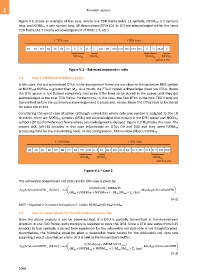Page 1078 - 5G Basics - Core Network Aspects
P. 1078
2 Transport aspects
Figure V.1 shows an example of this case, where one TDD frame holds 11 symbols, NSYMack is 2 symbols
long, and NSYMret is one symbol long. All downstream DTUs (D1 to D7) are acknowledged within the same
TDD frame (A1-7 means acknowledgement of DTUs 1-7, etc.)
Figure V.1 – Balanced asymmetric ratio
V.2 Case 2: NSYMret+NSYMack+1≥Mus
In this case, the last transmitted DTUs in the downstream frame are too close to the upstream RMC symbol
or NSYMack+NSYMret is greater than Mus. As a result, the FTU-R cannot acknowledge these last DTUs. Hence
the DTU queue is not flushed completely and some DTUs have to be stored in the queue until they get
acknowledged in the next TDD frame. Furthermore, in this case, the first DTUs in the new TDD frame are
transmitted before the upstream acknowledgement is processed. Hence, these first DTUs have to be stored
for some more time.
Considering the worst case situation (although unrealistic) where only one symbol is assigned to the US
direction, there are NSYMack symbols (DTUs) not acknowledged that remain in the DTU queue and NSYMret
symbols (DTUs) from the next frame whose acknowledgment is delayed. Figure V.2 illustrates this case. The
second ACK (A9-18) contains in this case information on DTUs D9 and D10 and they need NSYM ret
processing time for the transmitting node. In this configuration, ACK window offset is NSYMack.
Figure V.2 – Case 2
The achievable downstream net data rate for this case is given by:
8 (bits/byte ) MEMDS
AggAchieva bleNDR _ O(kb/s) min , MaxAggAchi evableNDR
(M DS NSYMack + NSYMret -1 M US )/M DS T F (ms)
(V-2)
NOTE – Equation V-2 reduces to Equation V-1 when NSYMack+NSYMret+1=Mus.
V.3 Case 3: Lower bound for the achievable net data rate
From the above analysis it can be observed that, if a DTU is partially transmitted in the downstream
direction in one TDD frame, extra memory is required to store this DTU. Since a DTU size varies from 0.25
symbols to four symbols, a closed form expression for the achievable net data rate is not straightforward.
Nevertheless, the following equation gives a reasonable lower bound for the achievable net data rate
assuming a worst case that an entire DTU is held in the transmitter's buffer:
8 (bits/byte ) MEMDS( - N )
AggAchieva bleNDR _ O(kb/s) min DTU , MaxAggAchi evableNDR
(M DS NSYM ack + NSYM ret -1 M US )/M DS T F (ms)
(V-3)
1068

